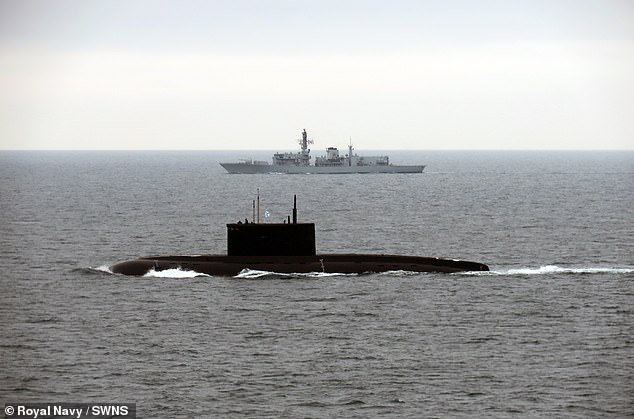The Royal Navy and RAF followed several Russian ships and submarines through the English Channel during the week at a time of heightened tension.
HMS Iron Duke and HMS Tyne have tracked four Russian vessels through UK waters in recent days while RAF jets intercepted a Russian strategic bomber on Wednesday.
Navy warships followed Russian advances to “protect national security” as four vessels sailed through the Channel and the North Sea.
Two RAF Typhoons were also sent from RAF Lossiemouth on Wednesday, supported by a Voyager from RAF Brize Norton, to intercept Russian Bear-F aircraft.
The developments come at a time of heightened tensions between Russia and Britain over Moscow’s ongoing war in Ukraine and Britain’s backing of kyiv, with a senior Kremlin spokesman and former president threatening to “sink” Britain this week.
HMS Iron Duke closely shadowed the Kilo-class submarine Novorossiysk and her support tug Evgeny Churov through the Strait of Dover and into the Atlantic.

HMS Iron Duke (rear right) shadows the Russian Navy’s Steregushchiy-class corvette RFS Stoiky

Russian President Vladimir Putin chairs a meeting with members of the Security Council via video conference at the Novo-Ogaryovo state residence outside Moscow, Russia, today

Interception of a Tu-95 Bear F captured by the pilot’s portable camera on Wednesday
“The island called Great Britain is likely to sink in the coming years,” Dmitry Medvedev wrote on his personal social media account, adding: “Our hypersonic missiles will help if necessary.”
Medvedev’s threat against Britain follows a series of statements by Putin’s propagandists calling for nuclear strikes to drown the UK under tsunamis triggered by its hypersonic missiles or the Poseidon high-speed underwater drone.
And Putin himself has warned that Britain and other Western countries supporting Ukraine will face the harshest consequences if they allow Ukraine to use long-range NATO-supplied missiles against military targets inside Russia.
Defence Secretary John Healey said: “The efforts of the Royal Navy and RAF over the past two weeks demonstrate their selfless commitment to protecting our national security.”
“This Government is committed to making the United Kingdom safe at home and strong abroad,” he added in a statement.
‘I would like to thank the members of our armed forces who took part in this operation; their professionalism and skill were on full display as they worked in perfect harmony with our NATO allies to uphold international standards.’
The Navy worked with its NATO allies to choreograph the tracking of the Kilo-class submarine Novorossiysk and its support tug Evgeny Churov through the Strait of Dover and into the Atlantic.
The careful operation began in early September when the Canadian warship HMCS Shawinigan escorted the diesel-powered submarine and its support vessel as they sailed from the Baltic and headed into the North Sea.
The Canadian patrol vessel handed over surveillance duties to the Royal Navy as the Russian ships approached the busy Strait of Dover.
From there, HMS Iron Duke ensured constant surveillance of the two vessels, using its numerous sensors, including its Wildcat helicopter, of 815 Naval Air Squadron, in the air.
The submarine remained on the surface throughout the operation.
Once the Russian ships had passed UK waters, HMS Iron Duke handed over observation duties to the Marine Nationale off the north-west coast of France, where the frigate FS Auvergne took over the mission.
The ship immediately returned to the North Sea for an almost identical operation, this time with the Steregushchiy-class corvette Stoiky and the tanker MT Yaz as it approached Dover, taking over shadowing duties from the Belgian Navy, whose patrol vessel BNS Castor had been keeping watch until then.
The RAF was also called in to track a Tupolev Tu-95 Bear strategic bomber flying near the UK.

Royal Navy warships have spent the past week shadowing the Russian Navy as four of its vessels sailed through the Channel and North Sea, helping to protect national security.
The Royal Navy said: ‘The RAF aircraft were launched under Nato command and worked closely with our partners to monitor the aircraft as they passed through international airspace.
‘Our Typhoon fighters escorted the aircraft out of the UK Flight Information Region and at no point did the Russian aircraft enter UK sovereign airspace.’
Typhoons are part of the RAF’s Rapid Reaction Alert, which keeps aircraft in Scotland and England on high alert 365 days a year, ready to defend and protect UK airspace.
During both voyages beyond the UK, the Russian warships and their support vessels were closely monitored by British forces to ensure they acted in a safe and non-threatening manner.
Travel is permitted under international law in accordance with the right of innocent passage.
“These were the fourth and fifth such operations for HMS Iron Duke since we emerged from an intense training period in July,” said HMS Iron Duke’s commanding officer, Commander David Armstrong.
‘I am extremely proud of the professionalism and selfless dedication my ship’s crew consistently demonstrates in the performance of their duty.
‘Maritime security operations of this nature are a core capability of the Royal Navy, with the protection of our sovereign waters and critical national infrastructure a key objective.’
Meanwhile, Russia has been conducting artillery-firing exercises in the Barents Sea as part of the largest naval exercise since the Cold War.
The new exercises included Northern Fleet forces launching Vulkan and Onyx cruise missiles against a simulated Western adversary in the Arctic Sea off the coasts of northern Norway and Russia.
The missile cruiser Marshal Ustinov and the Tu-142 anti-submarine aircraft took part in the exercises. In addition, Tu-22M3 bombers attacked a group of “enemy” ships.
The artillery fire at a maritime target was carried out by the strike group of ships of the Russian Northern Fleet, including the frigates Admiral Kasatonov and Admiral Golovko.
Naval exercises were also held in the Caspian Sea.


